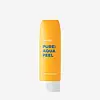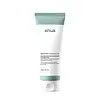What's inside
What's inside
 Key Ingredients
Key Ingredients

 Benefits
Benefits

 Concerns
Concerns

 Ingredients Side-by-side
Ingredients Side-by-side

Water
Skin ConditioningCellulose
AbsorbentDipropylene Glycol
HumectantBetaine
Humectant1,2-Hexanediol
Skin ConditioningGlycerin
HumectantSodium Hyaluronate
HumectantPyrus Malus Flower Extract
Skin ConditioningCeramide Ns
Skin ConditioningZea Mays Starch
AbsorbentGluconolactone
Skin ConditioningGold
Cosmetic ColorantNelumbo Nucifera Flower Extract
Skin ConditioningButylene Glycol
HumectantHydrolyzed Hyaluronic Acid
HumectantSodium Acetylated Hyaluronate
HumectantPolyglyceryl-10 Laurate
Skin ConditioningPolyglyceryl-10 Myristate
Skin ConditioningGlyceryl Caprylate
EmollientEthylhexylglycerin
Skin ConditioningCaprylyl Glycol
EmollientHydrogenated Lecithin
EmulsifyingPhytosteryl/Octyldodecyl Lauroyl Glutamate
Skin ConditioningCaprylic/Capric Triglyceride
MaskingGardenia Taitensis Callus Extract
AntioxidantSodium Carbomer
Emulsion StabilisingMaltodextrin
AbsorbentJasminum Officinale Oil
MaskingRose Flower Oil
MaskingWater, Cellulose, Dipropylene Glycol, Betaine, 1,2-Hexanediol, Glycerin, Sodium Hyaluronate, Pyrus Malus Flower Extract, Ceramide Ns, Zea Mays Starch, Gluconolactone, Gold, Nelumbo Nucifera Flower Extract, Butylene Glycol, Hydrolyzed Hyaluronic Acid, Sodium Acetylated Hyaluronate, Polyglyceryl-10 Laurate, Polyglyceryl-10 Myristate, Glyceryl Caprylate, Ethylhexylglycerin, Caprylyl Glycol, Hydrogenated Lecithin, Phytosteryl/Octyldodecyl Lauroyl Glutamate, Caprylic/Capric Triglyceride, Gardenia Taitensis Callus Extract, Sodium Carbomer, Maltodextrin, Jasminum Officinale Oil, Rose Flower Oil
Water
Skin ConditioningDisodium Cocoamphodiacetate
CleansingSodium Cocoyl Alaninate
Sodium Methyl Cocoyl Taurate
CleansingAcrylates/C10-30 Alkyl Acrylate Crosspolymer
Emulsion StabilisingDisodium 2-Sulfolaurate
CleansingSodium Chloride
MaskingGlycerin
HumectantMethylpropanediol
SolventHouttuynia Cordata Flower/Leaf/Stem Water
AntimicrobialHouttuynia Cordata Extract
Skin ConditioningQuillaja Saponaria Bark Extract
CleansingVincetoxicum Atratum Extract
Skin ConditioningAlthaea Rosea Flower Extract
Skin ConditioningChitosan
1,2-Hexanediol
Skin ConditioningCaprylyl Glycol
EmollientTromethamine
BufferingCoco-Glucoside
CleansingPanthenol
Skin ConditioningSalicylic Acid
MaskingSuccinic Acid
BufferingLauryl Hydroxysultaine
CleansingPolyglyceryl-4 Caprate
EmulsifyingEthylhexylglycerin
Skin ConditioningSodium Cocoyl Isethionate
CleansingSodium Citrate
BufferingSodium Phytate
Hexylene Glycol
EmulsifyingButylene Glycol
HumectantCitric Acid
BufferingProtease
ExfoliatingCaprylic/Capric Triglyceride
MaskingHydrogenated Lecithin
EmulsifyingTocopherol
AntioxidantCeramide NP
Skin ConditioningDipropylene Glycol
HumectantPentylene Glycol
Skin ConditioningCholesterol
EmollientParfum
MaskingWater, Disodium Cocoamphodiacetate, Sodium Cocoyl Alaninate, Sodium Methyl Cocoyl Taurate, Acrylates/C10-30 Alkyl Acrylate Crosspolymer, Disodium 2-Sulfolaurate, Sodium Chloride, Glycerin, Methylpropanediol, Houttuynia Cordata Flower/Leaf/Stem Water, Houttuynia Cordata Extract, Quillaja Saponaria Bark Extract, Vincetoxicum Atratum Extract, Althaea Rosea Flower Extract, Chitosan, 1,2-Hexanediol, Caprylyl Glycol, Tromethamine, Coco-Glucoside, Panthenol, Salicylic Acid, Succinic Acid, Lauryl Hydroxysultaine, Polyglyceryl-4 Caprate, Ethylhexylglycerin, Sodium Cocoyl Isethionate, Sodium Citrate, Sodium Phytate, Hexylene Glycol, Butylene Glycol, Citric Acid, Protease, Caprylic/Capric Triglyceride, Hydrogenated Lecithin, Tocopherol, Ceramide NP, Dipropylene Glycol, Pentylene Glycol, Cholesterol, Parfum
Ingredients Explained
These ingredients are found in both products.
Ingredients higher up in an ingredient list are typically present in a larger amount.
1,2-Hexanediol is a synthetic liquid and another multi-functional powerhouse.
It is a:
- Humectant, drawing moisture into the skin
- Emollient, helping to soften skin
- Solvent, dispersing and stabilizing formulas
- Preservative booster, enhancing the antimicrobial activity of other preservatives
Butylene Glycol (or BG) is used within cosmetic products for a few different reasons:
Overall, Butylene Glycol is a safe and well-rounded ingredient that works well with other ingredients.
Though this ingredient works well with most skin types, some people with sensitive skin may experience a reaction such as allergic rashes, closed comedones, or itchiness.
Learn more about Butylene GlycolThis ingredient is an emollient, solvent, and texture enhancer. It is considered a skin-softener by helping the skin prevent moisture loss.
It helps thicken a product's formula and makes it easier to spread by dissolving clumping compounds.
Caprylic Triglyceride is made by combining glycerin with coconut oil, forming a clear liquid.
While there is an assumption Caprylic Triglyceride can clog pores due to it being derived from coconut oil, there is no research supporting this.
Learn more about Caprylic/Capric TriglycerideCaprylyl Glycol is a humectant and emollient, meaning it attracts and preserves moisture.
It is a common ingredient in many products, especially those designed to hydrate skin. The primary benefits are retaining moisture, skin softening, and promoting a healthy skin barrier.
Though Caprylyl Glycol is an alcohol derived from fatty acids, it is not the kind that can dry out skin.
This ingredient is also used as a preservative to extend the life of products. It has slight antimicrobial properties.
Learn more about Caprylyl GlycolDipropylene Glycol is a synthetically created humectant, stabilizer, and solvent.
This ingredient helps:
Dipropylene glycol is technically an alcohol, but it belongs to the glycol family (often considered part of the ‘good’ alcohols). This means it is hydrating and gentle on skin unlike drying solvent alcohols like denatured alcohol.
As a masking agent, Dipropylene Glycol can be used to cover the smell of other ingredients. However, it does not have a scent.
Studies show Dipropylene Glycol is considered safe to use in skincare.
Learn more about Dipropylene GlycolEthylhexylglycerin (we can't pronounce this either) is commonly used as a preservative and skin softener. It is derived from glyceryl.
You might see Ethylhexylglycerin often paired with other preservatives such as phenoxyethanol. Ethylhexylglycerin has been found to increase the effectiveness of these other preservatives.
Glycerin is already naturally found in your skin. It helps moisturize and protect your skin.
A study from 2016 found glycerin to be more effective as a humectant than AHAs and hyaluronic acid.
As a humectant, it helps the skin stay hydrated by pulling moisture to your skin. The low molecular weight of glycerin allows it to pull moisture into the deeper layers of your skin.
Hydrated skin improves your skin barrier; Your skin barrier helps protect against irritants and bacteria.
Glycerin has also been found to have antimicrobial and antiviral properties. Due to these properties, glycerin is often used in wound and burn treatments.
In cosmetics, glycerin is usually derived from plants such as soybean or palm. However, it can also be sourced from animals, such as tallow or animal fat.
This ingredient is organic, colorless, odorless, and non-toxic.
Glycerin is the name for this ingredient in American English. British English uses Glycerol/Glycerine.
Learn more about GlycerinHydrogenated Lecithin is created from the hydrogenation of lecithin (a group of phospholipids). Hydrogenation is a chemical reaction between hydrogen and another element.
This ingredient is an emollient and emulsifier. As an emollient, it helps soften skin by trapping moisture within. As an emulsifier, it prevents oil and water ingredients from separating.
Water. It's the most common cosmetic ingredient of all. You'll usually see it at the top of ingredient lists, meaning that it makes up the largest part of the product.
So why is it so popular? Water most often acts as a solvent - this means that it helps dissolve other ingredients into the formulation.
You'll also recognize water as that liquid we all need to stay alive. If you see this, drink a glass of water. Stay hydrated!
Learn more about Water